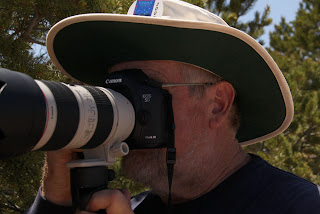
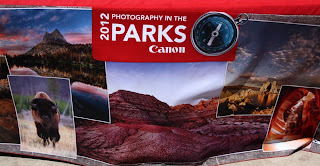 One of the big surprises I found out on the first night at the Grand Canyon Star Party was that Canon Cameras was running a "Photography in the Parks" program. They were offering free photography workshops rimside. The best part - you could use your own equipment, or even better - leave a credit card and driver's license and you could use theirs! They had state-of-the-art cameras and lenses available, including an 800mm F/5.6 lens on static display that I would have hated to cart to the rim at 10 pounds w/out camera body or tripod... Melinda and I signed up for the 12:30 workshop on our second day. She chose to keep her own camera, but borrow a nicer zoom - I stepped up to a brand new 5D Mark III that I've had my eye on since it was released a couple months ago, with a very nice 70-200 F/2.8 zoom. That pair would have run me about $5K had I dropped it into the Canyon, but I survived to tell the tale!
One of the big surprises I found out on the first night at the Grand Canyon Star Party was that Canon Cameras was running a "Photography in the Parks" program. They were offering free photography workshops rimside. The best part - you could use your own equipment, or even better - leave a credit card and driver's license and you could use theirs! They had state-of-the-art cameras and lenses available, including an 800mm F/5.6 lens on static display that I would have hated to cart to the rim at 10 pounds w/out camera body or tripod... Melinda and I signed up for the 12:30 workshop on our second day. She chose to keep her own camera, but borrow a nicer zoom - I stepped up to a brand new 5D Mark III that I've had my eye on since it was released a couple months ago, with a very nice 70-200 F/2.8 zoom. That pair would have run me about $5K had I dropped it into the Canyon, but I survived to tell the tale!Now of course, had we been thinking, the noon workshop is about the worst time to go out to photograph the Canyon. The sun is overhead, no shadows, just lots of featureless brilliant light. Our instructor, Kyle, a professional specializing in outdoor imaging - mostly surfers and rock climbers, did a good job with our intermediate/advanced group - making us move away from our normal "program" mode of shooting and visualizing the exposures needed to properly image the scene.
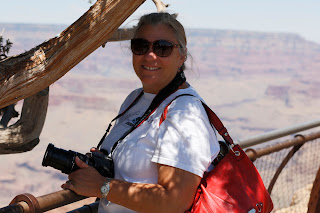 In the 90 minutes of workshop, I couldn't well put much experience under my belt with the new 5D III, but I really liked it! It had some clunky features like the 3 or 4 fingers you need to simply zoom in on an image on the screen, but it has some features I really liked, including an in-camera HDR mode - taking 3 images in quick sucession(at 6 frames/second) and combining them into a nicely exposed image displaying a much greater range than a single frame could. The image of Melinda at left here is a good example. Since she is in shade and the Canyon in bright sunlight, a conventional exposure would have required a lot of work to display properly. This image is straight out of the camera's HDR mode. It has a number of interesting features for astronomy, including an ISO range topping out at 25,600 (expandable to 102,400!), and a full 35mm format sensor of 24X36mm (twice the area of my XSi). If only they offered the astronomy version of the 5DIII with the slightly red -shifted cutoff filter and the articulated screen - it would have been on my wish list! But it was still a thrill to hold new cameras and lenses in your hands, and using them at will. I also got to play with the Canon 8-15 zoom that I wasn't too impressed with (a little fuzzy wide open, where I'd be using it for astro-imaging). I would have liked to try the 15mm F/2.8 zoom, but they didn't have one...
In the 90 minutes of workshop, I couldn't well put much experience under my belt with the new 5D III, but I really liked it! It had some clunky features like the 3 or 4 fingers you need to simply zoom in on an image on the screen, but it has some features I really liked, including an in-camera HDR mode - taking 3 images in quick sucession(at 6 frames/second) and combining them into a nicely exposed image displaying a much greater range than a single frame could. The image of Melinda at left here is a good example. Since she is in shade and the Canyon in bright sunlight, a conventional exposure would have required a lot of work to display properly. This image is straight out of the camera's HDR mode. It has a number of interesting features for astronomy, including an ISO range topping out at 25,600 (expandable to 102,400!), and a full 35mm format sensor of 24X36mm (twice the area of my XSi). If only they offered the astronomy version of the 5DIII with the slightly red -shifted cutoff filter and the articulated screen - it would have been on my wish list! But it was still a thrill to hold new cameras and lenses in your hands, and using them at will. I also got to play with the Canon 8-15 zoom that I wasn't too impressed with (a little fuzzy wide open, where I'd be using it for astro-imaging). I would have liked to try the 15mm F/2.8 zoom, but they didn't have one...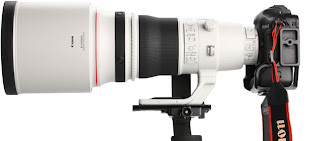 I did get to hang out with Kyle, our instructor a couple times - or rather, I pestered him a few times! He was interested in astronomy imaging and was intrigued with the time lapse images I was taking while the star party was going on. I jokingly offered that if he brought over that 800mm telephoto, we'd hook it up piggyback on my C-14. He bit, then I had to back off, and asked about a 300mm or 400mm. He indicated that Canon had a new 400mm F/2.8 lens, and would bring it back the next night.
I did get to hang out with Kyle, our instructor a couple times - or rather, I pestered him a few times! He was interested in astronomy imaging and was intrigued with the time lapse images I was taking while the star party was going on. I jokingly offered that if he brought over that 800mm telephoto, we'd hook it up piggyback on my C-14. He bit, then I had to back off, and asked about a 300mm or 400mm. He indicated that Canon had a new 400mm F/2.8 lens, and would bring it back the next night.
After the crowd thinned a bit after 10pm, he showed up right on schedule and I removed the C-14, replacing it with the huge telephoto. I could tell he knew a lot more about the 5DIII than I did the way he was whipping through menus, but after a couple test exposures, we decided that we would use the lens wide open at F/2.8, and expose for 1 minute at an ISO of 3,200. That put the histogram right where we wanted it at about 30% or 40% of the way to the right. I was telling him about taking multiple frames and stacking them to improve the signal-to-noise, but frankly, the images looked pretty darn good right off the back of the camera. Looking at the frames in the computer, even at ISO 3200 there is very little hot pixel activity to correct, so these frames have no dark corrections. The G-11 had to work hard to properly track, even at the short focal length of 400mm, but I know there was some gear backlash and the wind was quite blustery that night, so there is some elongation at the full resolution. And of course, we were impatient, and at most took only 3-4 exposures to stack...
 The first frame up was the region around Antares - a nice combination of globular clusters, bright nebulosity lit up by the brilliant red giant, and dark clouds silhouetted against the glowing Milky Way. I had shot it with the 70-200 zoom a month ago and the 30 minutes of exposure is wider and perhaps deeper than this 4 minutes of total exposure, but this combo performed well. The one issue with shooting fast lenses is evident here, particularly when you want to stretch the contrast to the max to bring out details - fast lenses result in vignetting - light falls off in the corners with fast lenses. If we had lots of time, I would have stopped it down to F/3.5 or 4 and doubled the exposures to improve overall sharpness and reduce the light fall-off in the corners.
The first frame up was the region around Antares - a nice combination of globular clusters, bright nebulosity lit up by the brilliant red giant, and dark clouds silhouetted against the glowing Milky Way. I had shot it with the 70-200 zoom a month ago and the 30 minutes of exposure is wider and perhaps deeper than this 4 minutes of total exposure, but this combo performed well. The one issue with shooting fast lenses is evident here, particularly when you want to stretch the contrast to the max to bring out details - fast lenses result in vignetting - light falls off in the corners with fast lenses. If we had lots of time, I would have stopped it down to F/3.5 or 4 and doubled the exposures to improve overall sharpness and reduce the light fall-off in the corners.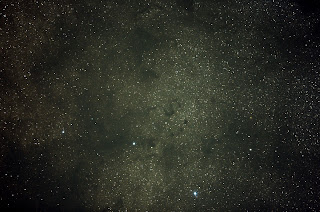 We worked our way east to some dark nebulae in Ophiuchus. There the glow of the Milky Way shows off the clouds of obscuring matter when they block the more distant star clouds. Dead center is Barnard 72, the Snake Nebula, so named for its sinuous outline. Other dark clouds are similarly named, but the field is just a little too small to show the other major structures of the Pipe nebula just off the bottom and the Prancing Horse, parts of which can be seen at left here. This is 3 minutes of total exposure, again with the 400mm at F/2.8 and an ISO of 3,200.
We worked our way east to some dark nebulae in Ophiuchus. There the glow of the Milky Way shows off the clouds of obscuring matter when they block the more distant star clouds. Dead center is Barnard 72, the Snake Nebula, so named for its sinuous outline. Other dark clouds are similarly named, but the field is just a little too small to show the other major structures of the Pipe nebula just off the bottom and the Prancing Horse, parts of which can be seen at left here. This is 3 minutes of total exposure, again with the 400mm at F/2.8 and an ISO of 3,200.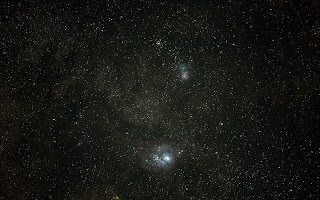 Now for some bright nebulae, next we moved a little more east to the great star formation areas of Messier 8 and 20. These are flourescing clouds of mostly hydrogen gas. As I mentioned above, the infrared-bocking filters of modern digital cameras block much of the red light of these clouds. This entire area would likely glow red at low levels from the h-alpha emission. M8, the Lagoon Nebula is at bottom center, M20 the Triffid Nebula is top center, and the star cluster to its upper left is M21. As above, 3 exposures of 60 seconds each were combined.
Now for some bright nebulae, next we moved a little more east to the great star formation areas of Messier 8 and 20. These are flourescing clouds of mostly hydrogen gas. As I mentioned above, the infrared-bocking filters of modern digital cameras block much of the red light of these clouds. This entire area would likely glow red at low levels from the h-alpha emission. M8, the Lagoon Nebula is at bottom center, M20 the Triffid Nebula is top center, and the star cluster to its upper left is M21. As above, 3 exposures of 60 seconds each were combined.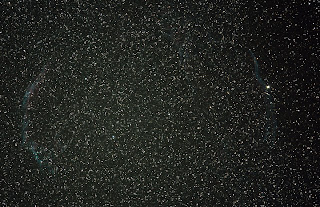 Lastly, we went for something different, the supernova remnant of the Veil nebula in Cygnus. A few decades ago this was considered a very faint object, now revealed even in average-sized telescopes with narrow band filters that darken the sky while transmitting the specific wavelengths of the nebula. It is still tough to get good exposures with standard camera techniques, but here the 3 minutes of exposure do a pretty good job at recording the filaments from the supernova that went off about 8,000 years ago. It has now expanded into arcs about 3 degrees across.
Lastly, we went for something different, the supernova remnant of the Veil nebula in Cygnus. A few decades ago this was considered a very faint object, now revealed even in average-sized telescopes with narrow band filters that darken the sky while transmitting the specific wavelengths of the nebula. It is still tough to get good exposures with standard camera techniques, but here the 3 minutes of exposure do a pretty good job at recording the filaments from the supernova that went off about 8,000 years ago. It has now expanded into arcs about 3 degrees across.













1 comment:
O boy! Wish I could have been there for the Canon guy's lenses. Nice shots BTW! ~Dave
Post a Comment